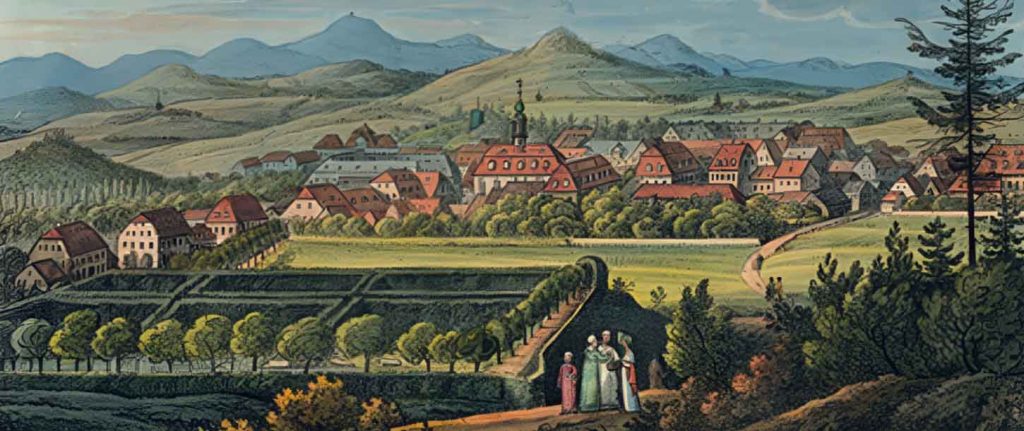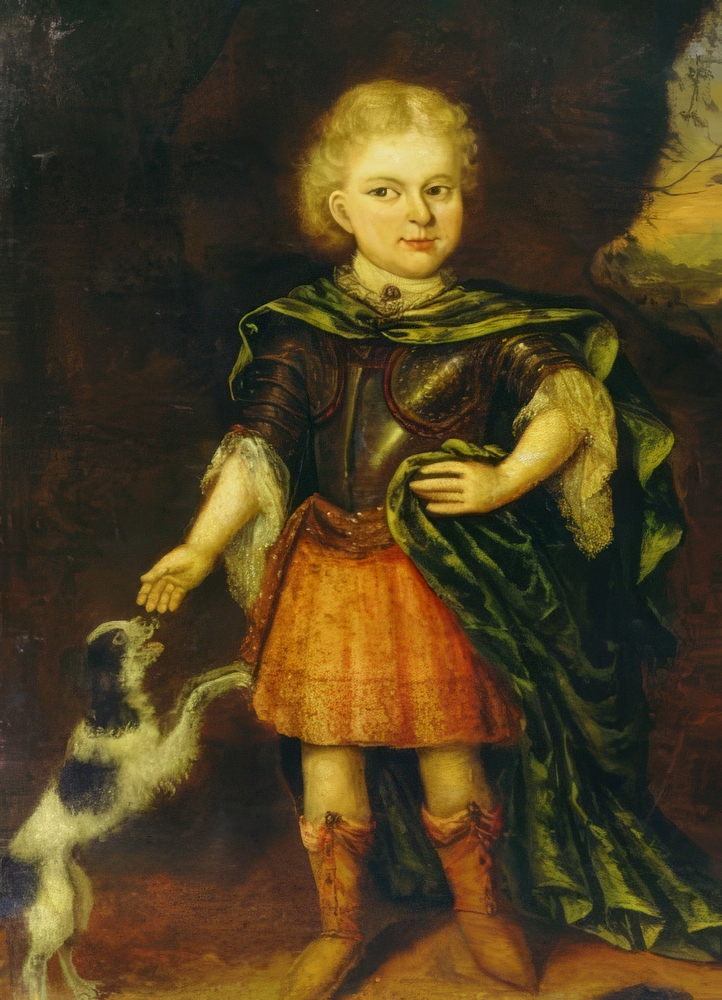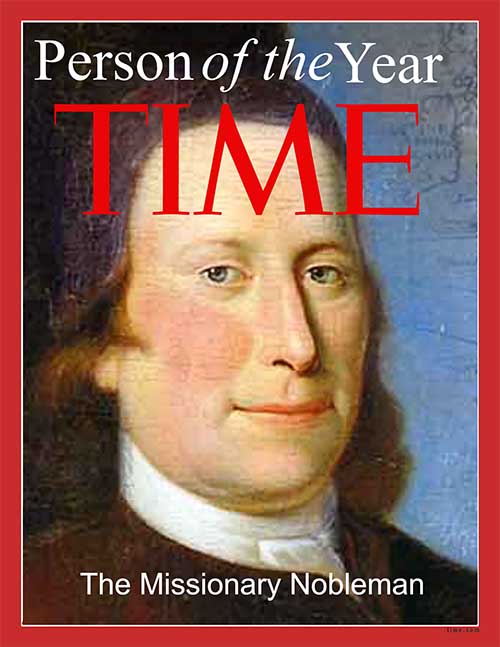Nicholas Ludwig, Count Zinzendorf, was born in Dresden in 1700. He was very much a part of the Pietist movement in Germany, which emphasized personal piety and an emotional component to the religious life. This was in contrast to the state Lutheran Church of the day, which had grown to symbolize a largely intellectual faith centered on belief in specific doctrines. He believed in “heart religion,” a personal salvation built on the individual’s spiritual relationship with Christ.
Zinzendorf was born into one of the most noble families of Europe. His father died when he was an infant, and he was raised at Gros Hennersdorf, the castle of his influential Pietistic grandmother. Stories abound of his deep faith during childhood. As a young man he struggled with his desire to study for the ministry and the expectation that he would fulfill his hereditary role as a Count. As a teenager at Halle Academy, he and several other young nobles formed a secret society, “The Order of the Grain of Mustard Seed.” The stated purpose of this order was that the members would use their position and influence to spread the Gospel. As an adult, Zinzendorf later reactivated this adolescent society, and many influential leades of Europe ended up joining the group. A few included the King of Denmark, the Archbishop of Canterbury, and the Archbishop of Paris.
See Feti’s Ecce Homo painting here.
During his Grand Tour (a rite of passage for young aristocrats) Nicolas visited an art museum in Dusseldorf where he saw a Domenico Feti painting titled Ecce Homo, “Behold the Man.” It portrayed the crucified Christ with the legend, “This have I done for you – Now what will you do for me?” The young count as profoundly moved and appears to have had an almost mystical experience while looking at the painting, feeling as if Christ himself was speaking those words to his heart. He vowed that day to dedicate his life to service to Christ.
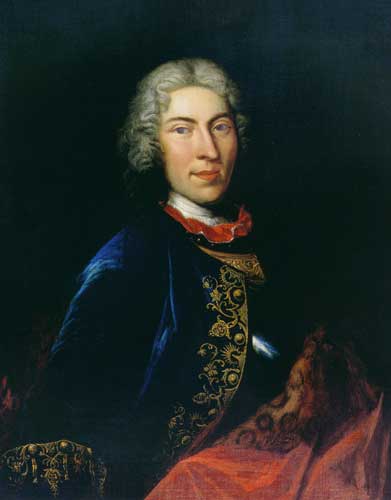
Zinzendorf married Erdmuth Dorothea von Reuss, and assumed his duties as a young noble in the courts of King August the Strong. In 1722, he was approached by a group of Moravians to request permission to live on his lands. He granted their request, and a small band crossed the border from Moravia to settle in a town they called Herrnhut, or “the Lord’s Watch.” Zinzendorf was intrigued by the story of the Moravians, and began to read about the early Unity at the library in Dresden. His tenants went through a period of serious division, and it was then in 1727 that Zinzendorf left public life to spend all his time at his Berthelsdorf estate working with the troubled Moravians. Largely due to his leadership in daily Bible studies, the group came to formulate a unique document, known as the “Brotherly Agreement,” which set forth basic tenets of Christian behavior. Residents of Herrnhut were required to sign a pledge to abide by these Biblical principals. There followed an intense and powerful experience of renewal, often described as the “Moravian Pentecost.” During a communion service at Berthelsdorf, the entire congregation felt a powerful presence of the Holy Spirit, and felt their previous differences swept away. This experience began the Moravian renewal, and led to the beginning of the Protestant World Mission movement.
“Zinzendorf is probably the most important German theologian between Martin Luther and Schleiermacher.”
– Dr Gary Kinkel, Professor of Religion, Simpson College
In 1731, while attending the coronation of Christian VI in Copenhagen, the young Count met a converted slave from the West Indies, Anthony Ulrich. Anthony’s tale of his people’s plight moved Zinzendorf, who brought him back to Herrnhut. As a result, two young men, Leonard Dober and David Nitchmann, were sent to St. Thomas to live among the slaves and preach the Gospel. This was the first organized Protestant mission work, and grew rapidly to Africa, America, Russia, and other parts of the world. By the end of Zinzendorf’s life there were active missions from Greenland to South Africa, literally from one end of the earth to the other. Though the Baptist missionary Wliam Carey is often refered to as the “Father of Modern Missions,” he himself would credit Zinzendorf with that role, for he often refered to the model of the earlier Moravians in his journal.
Zinzendorf himself visited St. Thomas, and later visited America. There he sought to unify the German Protestants of Pennsylvania, even proposing a sort of “council of churches” where all would preserve their unique denominational practices, but would work in cooperation rather than competition. He founded the town of Bethlehem, where his daughter Benigna organized the school which would become Moravian Academy and Moravian University. His overwhelming interest in the colonies involved evangelising the native Americans, and he travelled into the wilderness with Indian agent Conrad Weiser to meet with the chieftains of several tribes and clans. As far as we have been able to identify, he is the only European noble to have gone out to meet the native American leaders in this manner.
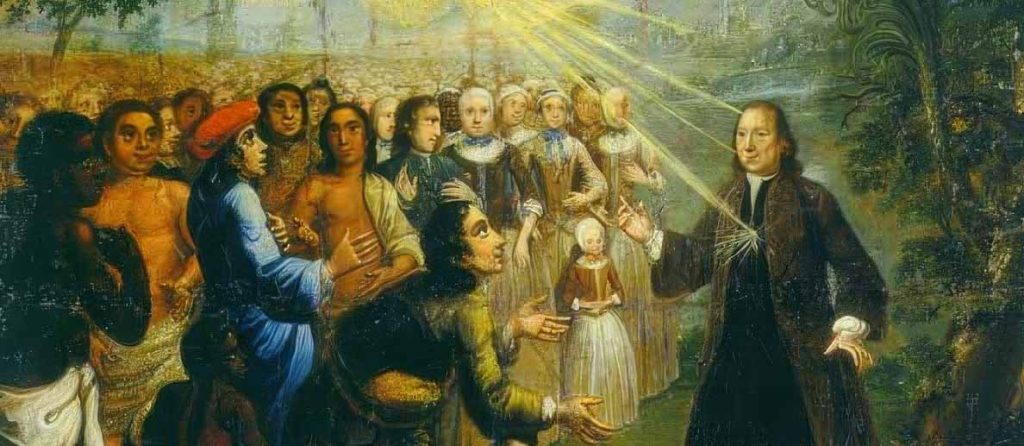
Zinzendorf’s theology was extraordinarily Christ-centered and innovative. It focussed intensely on the personal experience of a relationship with Christ, and an emotional experience of salvation rather than simply an intellectual assent to certain principles. Dr David Schattschneider, Dean of Moravian Theological Seminary in Bethlehem, PA, says that it is probably the fact that Zinzendorf did not attend seminary that allowed his thinking could be so creative. Zinzendorf cast the Trinity and the believers in terms of a family, referring often to the Holy Spirit as “mother.” He accorded women a much more substantial role in church life than was normal for the eighteenth century, and suffered great criticism as a result. He allowed women to preach, to hold office, and to be ordained. Anna Nitschmann, the leader of the Single Sisters and later Zinzendorf’s second wife, seems to have functioned as a bishop among the women.
If Time Magazine had existed in the 18th century, Zinzendorf would have been on the cover — twice!
But all Zinzendorf’s thinking also focused on missionary outreach and renewal. He envisioned the Moravians not as a separate denomination, but as a dynamic renewal society which would serve to revitalize existing denominations and help create new work in mission areas. There are numerous churches in Pennsylvania where Moravians would start a church and school for the settlers and native Americans, and then turn it over to the Lutheran Church, the Reformed Church, or whatever denomination they perceived to be the strongest in that area.
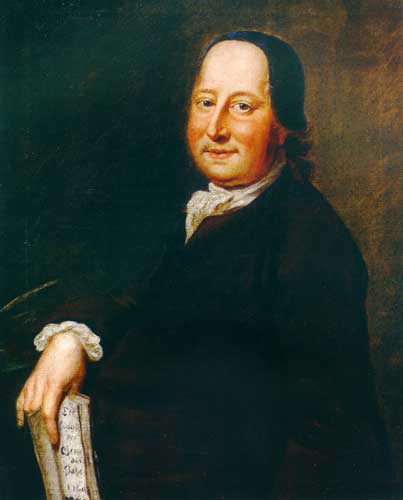
But Zinzendorf was not perfect – his blind spot was his rather uncritical acceptance of the social structures of his day. For example, it was seen as God’s will that he should himself be born to a noble family, with all the privilege and power that came with that; he was responsible to use his power faithfully to build the kingdom of God. This was in fact the findamental idea behind his “Order of the Grain of Mustard Seed.” By the same token, commoners were born to their lot in life, and that was a part of God’s plan. And slaves were born to that low lot in life, and they were morally obligated to be the best slaves to their masters that they could be. Even while treating believing African slaves or native Americans as spiritual equals (a very radical and controversial thing in the day), the Count did not openly oppose the institution of slavery. This may have been because he realized that such open opposition would result in the Moravians being banned from work with the slaves in the Caribbean. Some Moravians did work secretly to oppose slavery; many of the accounts of what slave life was like that were used by Wilberforce and other abolitionists came from communications with Moravian missionaries on St Thomas and other islands.
Zinzendorf came to know John and Charles Wesley, who had been converted through their contact with the Moravians. John Wesley later had a split with Zinzendorf and the Moravians over theological issues, and founded the Methodist Church; but both, especially Charles, retained warm affection for the Moravians throughout their lives. Many of the ideas that the Wesleys used in early Methodism (lovefeasts, small groups/bands) came from the Moravians.
During his final illness, Zinzedorf asked Davidi Nitschmann, “Did you suppose in the beginning that the Savior would do as much as we now really see, in the various Moravian settlements, amongst the children of God of other denominations and amongst the heathen? I only entreated of him a few of the firstfruits of the latter, but there are now thousands of them. Nitschmann, what a formidable caravan from our church already stands around the Lamb!”
He died in 1760 at Herrnhut. Anna Nitschmann, his second wife, died only a few days later.
– Rev John Jackman
Revised on May 15, 2024
Related articles:
Zinzendorf’s Death: Moravian Archives Journal, May, 2010
The Rich Young Ruler . . . Who Said Yes! – Christian History Institute, 1982

